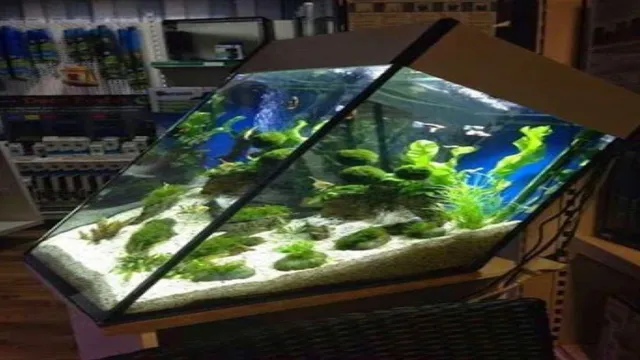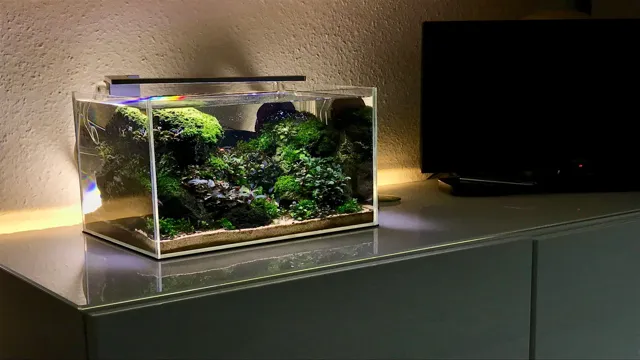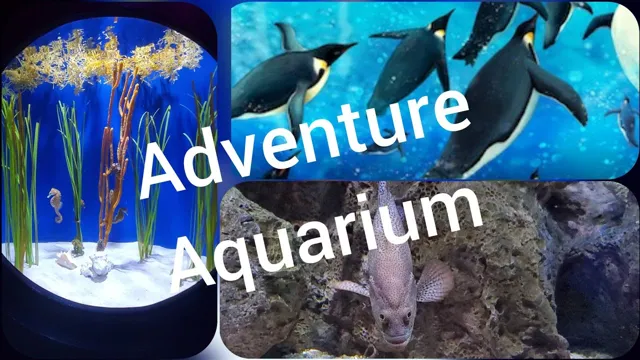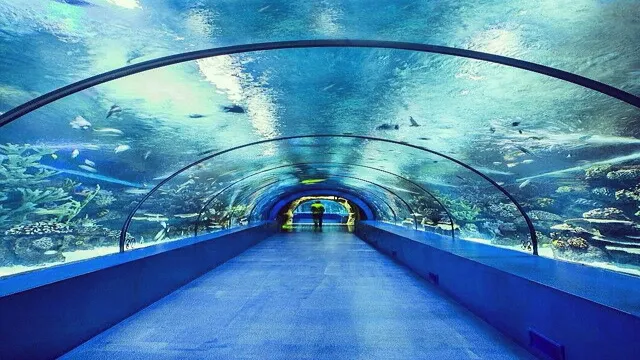Welcome to the wonderful world of aquariums! Developing your own aquarium is an exciting journey that requires passion, dedication, and patience. It’s an opportunity to create a little piece of nature in your home and observe the fascinating behaviors of aquatic life. From selecting the perfect tank to choosing the right fish, this guide will provide you with all the information you need to start your own aquarium.
Creating an aquarium can be a complex process, but with the right guidance, it can be a rewarding experience. This guide will provide you with tips on selecting the right tank size, choosing the best filtration system, understanding lighting and temperature requirements, and so much more. Whether you’re a beginner or an experienced hobbyist, this guide will help you create a stunning underwater world that you can be proud of.
Not only does having an aquarium provide visual appeal, but it is also known to have therapeutic benefits. Studies have shown that watching fish can help reduce stress and anxiety, lower blood pressure, and promote relaxation. So, not only will your aquarium bring beauty to your home, but it could also have a positive impact on your mental health and well-being.
In the following sections, we will dive deeper into the world of aquariums and provide you with the knowledge needed to create your own little slice of paradise. So, grab a cup of coffee and let’s get started on this exciting journey together!
Planning and Designing Your Aquarium
Developing your own aquarium can be an exciting project, but it requires careful planning and designing to ensure the best results. Before starting, research the type of fish and plants you want to feature in your aquarium and their requirements for space and maintenance. Determine the size and shape of your tank, considering factors like available space in your home and the type of environment you want to recreate.
Next, consider the filtration and lighting systems needed to maintain a healthy ecosystem for your aquatic pets. You’ll also need to choose decorations like rocks, plants, and other accessories to create a natural environment for your fish to thrive. By taking the time to plan and design your aquarium, you’ll be well on your way to creating a beautiful and healthy aquatic ecosystem right in your own home.
Choosing Your Aquarium Size and Shape
When it comes to planning and designing your aquarium, one of the first decisions you need to make is the size and shape of your tank. This can seem overwhelming, but it’s important to consider a few key factors before making your final decision. The main keyword for this article is “aquarium size and shape,” which means you need to focus on the importance of finding the right size and shape for your tank.
When choosing the size of your aquarium, you need to consider the amount of space you have available, the type of fish you want to keep, and your budget. For example, if you plan on housing large fish or having a lot of plants, you’ll need a larger tank to provide enough room for them to thrive. The shape of your aquarium is also important, as it can impact the flow of water and the types of decorations you can use.
Think about the aesthetic you want to achieve and what will work best in your space. With careful consideration of these factors, you can choose the perfect size and shape for your aquarium and create a beautiful and healthy environment for your fish to call home.

Deciding on the Type of Aquarium: Freshwater or Saltwater
When it comes to planning and designing your aquarium, one of the biggest decisions you’ll need to make is whether you want a freshwater or saltwater setup. Both have their benefits and challenges, so it’s important to consider your level of experience, budget, and long-term goals. Freshwater aquariums are generally easier and less expensive to set up and maintain, making them a great choice for beginners or those on a budget.
Plus, there are a wide variety of freshwater fish and plants to choose from, allowing for endless creativity and customization. On the other hand, saltwater aquariums can be more complex and costly, but they offer a unique and stunning underwater world filled with exotic fish and corals. Ultimately, the decision comes down to personal preference, but it’s important to do your research and consult with experienced aquarists before making your choice.
Selecting the Right Location for Your Aquarium
When it comes to planning and designing your aquarium, choosing the location is crucial. You want to select a spot that is stable, level, and away from any direct sunlight or drafts. A good location will ensure your fish thrive and your aquarium remains healthy.
Ideally, the location should also be convenient for you to access for maintenance and cleaning. You’ll want to avoid placing your aquarium near doors or windows where there is frequent foot traffic, as this can cause stress for your fish and disturb the water temperature. Additionally, try to keep your aquarium away from electronic devices that emit heat, as this can raise the water temperature and cause harm.
Taking the time to choose the right location for your aquarium will help ensure the long-term success of your aquatic hobby.
Assembling Your Aquarium Setup
Developing an aquarium setup can be a fun and rewarding experience, but it can also become overwhelming if you’re not prepared. Firstly, you need to choose the right tank size and shape for your space and the fish you plan to keep. Remember that you’ll also need a stand that can support the weight of the tank when it’s full of water.
Next, you’ll need a filter system to keep the water clean and clear. There are many types of filters available, such as canister filters and power filters, so choose one that’s appropriate for your tank size and fish type. You’ll also need a heater to maintain the water temperature, a thermometer to monitor it, and lighting to simulate a natural day/night cycle for your fish.
Finally, you’ll need substrate, which is the material that lines the bottom of your tank, to create a natural environment for your fish and plants. Assemble your aquarium setup carefully and ensure that everything is compatible with each other before introducing any fish. (See Also: How to Grow Moss on Stone in Aquarium: Tips and Tricks for a Vibrant Aquascape)
Choosing the Right Filtration System
When it comes to assembling your aquarium setup, choosing the right filtration system is a crucial step. The filtration system ensures that your aquarium’s water remains clear and clean for your fish to thrive in a healthy environment. There are three main types of filtration systems: mechanical, chemical, and biological.
Mechanical filtration takes care of debris and particles in the water column, while chemical filtration focuses on water chemistry and removes harmful substances. Biological filtration relies on beneficial bacteria to break down toxins and ammonia in the water. It’s important to consider the size of your aquarium and the types of fish you will have when choosing your filtration system.
A larger aquarium will require a larger filtration system to provide adequate filtration, and certain types of fish may produce more waste and require stronger filtration. Don’t skimp on your filtration system – it’s vital to the overall health and well-being of your aquatic pets.
Selecting Appropriate Lighting and Heating
When putting together your aquarium setup, one of the most important aspects to consider is the lighting and heating. Fish rely on proper lighting to regulate their internal clock, and the right temperature is essential for their health and well-being. The key is to select lighting that mimics natural sunlight, as this will help promote natural behaviors and vibrant colors in your fish.
For heating, an adjustable submersible heater is a good investment, as it allows you to easily control the temperature within your tank. Just make sure to choose the appropriate wattage for your tank size. Additionally, it’s important to monitor the temperature regularly, especially during seasonal changes or if you have a power outage.
Investing in quality lighting and heating will not only benefit your fish, but will also enhance the overall aesthetic of your aquarium.
Adding Substrate and Decorations
When it comes to setting up your aquarium, adding substrate and decorations is a crucial step in creating a natural and visually appealing environment for your fish. Substrate provides a foundation for your plants and a natural habitat for your fish, while decorations such as rocks, driftwood, and plants help create a naturalistic underwater scene. It’s important to choose the right type of substrate for your specific fish species and to make sure it is thoroughly washed before adding it to your aquarium.
When it comes to decorations, consider your fish’s habits and natural environment, and choose items that will provide hiding spots and resting areas. Adding plants not only adds to the aesthetic appeal but also provides oxygen and helps maintain water quality. Overall, taking the time to carefully plan and assemble your aquarium setup will not only benefit your fish but also provide you with a visually stunning addition to your home.
Adding Water and Testing Water Parameters
Adding water and testing water parameters is a crucial aspect of assembling your aquarium setup. Before introducing any fish or plants into the tank, you must ensure that the water is suitable for them to thrive in. If you’re using tap water, start by adding a water conditioner to remove harmful chemicals such as chlorine and chloramine.
Once you’ve added the water conditioner, you can begin filling your tank. After the tank is filled, you should test the water parameters such as pH, ammonia, nitrite, and nitrate levels. It’s important to maintain stable water parameters to keep your fish healthy, as fluctuating levels can cause stress and even illness.
You can use test strips or liquid testing kits to check the water parameters. If the water parameters are not within the ideal range, you may need to make adjustments. For example, if your pH levels are too high or low, you can add pH adjusters to bring it back to a healthy level.
If ammonia, nitrite, or nitrate levels are high, you may need to perform a partial water change and/or add a biological filter to help break down harmful substances. Remember to regularly monitor and maintain your water parameters to keep your fish healthy and happy in their new home. With proper care and attention, your aquarium setup can become a thriving and beautiful addition to your home.
Introducing Aquatic Life into Your Aquarium
When it comes to developing an aquarium, adding aquatic life is an essential step. However, it can be overwhelming trying to figure out where to begin. First, consider the type of aquatic creatures you want in your tank and their specific needs regarding water temperature, pH levels, and tank size.
Once you have determined this, you can begin selecting your fish or other aquatic organisms. It’s important to research each species thoroughly to ensure they can coexist peacefully and have compatible diets. Additionally, make sure to cycle your tank before adding any aquatic life to establish a healthy environment.
This step helps establish beneficial bacteria while reducing harmful toxins. Overall, adding aquatic life to your aquarium can be an exciting but crucial step in creating a thriving ecosystem. By taking the time to research and properly care for your aquatic organisms, you can enjoy a beautiful and healthy tank for years to come. (See Also: How to Fill Aquarium with Water: A Step-by-Step Guide for Beginners)
Choosing the Right Fish and Invertebrates
When it comes to introducing aquatic life into your aquarium, choosing the right fish and invertebrates is crucial. It’s important to consider the size of your tank, the water parameters, and the compatibility of different species. Researching the specific needs of each species and their behavior in community settings can also help ensure a harmonious and thriving environment for your aquatic pets.
One great option for beginners is to choose hardy species like guppies, tetras, or shrimp that can tolerate a range of conditions and won’t break the bank. It’s also helpful to work with a knowledgeable retailer or seek guidance from online forums and experienced hobbyists to prevent any common mistakes that could harm the health of your new additions. With careful research and planning, introducing new fish and invertebrates can be a rewarding experience that enhances the beauty and diversity of your aquarium.
Establishing a Balanced Ecosystem
Introducing aquatic life into your aquarium is a great way to establish a balanced ecosystem that is not only beautiful but also beneficial. Fish, snails, shrimp, and plants are all important components of an aquarium ecosystem. Each of these organisms plays a crucial role in maintaining a clean and healthy environment for the others.
For example, fish produce waste that helps provide nutrients for plants, while snails and shrimp help control algae growth. When adding new aquatic life to your aquarium, it’s important to research each species for compatibility, behavior, and water requirements. This will help ensure that your ecosystem remains balanced and harmonious.
So, go ahead and add some colorful fish, snails, or shrimp to your aquarium today, and watch as they play their part in creating a thriving aquatic community.
Maintaining Your Aquarium
Developing an aquarium can be an incredibly rewarding experience. Once you have your tank set up, it’s important to maintain it properly to ensure a healthy environment for your aquatic pets. Regular water changes are crucial to remove waste and excess nutrients that can harm your fish and plants.
Test the water regularly for pH, ammonia, and nitrate levels to ensure they stay within a safe range. Algae growth can also become a problem, so make sure to regulate the amount of light that your tank receives and scrub away any buildup as needed. Additionally, feeding your fish the correct amount of food and keeping the tank clean can help prevent the occurrence of diseases that are common in aquariums.
Overall, the key to developing a thriving aquarium is to make sure that you are staying on top of maintenance tasks and keeping a close eye on any changes within your tank.
Performing Regular Water Changes and Cleaning
Maintaining an aquarium can be a rewarding experience, but it requires frequent cleaning and water changes to ensure the health and happiness of your fish. Regular cleaning of the tank can help prevent algae growth and bacteria buildup, which can harm your fish if left unchecked. One way to clean your aquarium is by using an algae scraper, which can be used to remove algae from the sides of the tank and any decorations.
It’s also important to check the filter regularly and replace it if necessary. In addition to cleaning, it’s important to perform regular water changes to ensure that the water remains clear and healthy. A good rule of thumb is to change out 25% of the water every two weeks.
This will help remove any buildup of waste and maintain proper water chemistry. Overall, maintaining your aquarium requires a bit of effort, but the result is a beautiful and healthy underwater world for your fish to thrive in.
Monitoring Water Parameters and Adjusting as Necessary
Maintaining an aquarium is not just about having fish in water. It requires regular monitoring of the water parameters and adjusting them as required. The water in your aquarium must be chemically balanced for the survival of your aquatic pets.
This means monitoring and adjusting parameters such as pH, temperature, ammonia, nitrite, and nitrate levels. These factors can change over time due to various reasons such as fish waste, overfeeding, or even water evaporation. Therefore, it’s essential to test the water parameters regularly using appropriate testing kits and adjust them accordingly.
For instance, if the pH is too high or too low, you can add pH adjusters to balance the water. Similarly, if the ammonia level is too high, it can be harmful to fish, so you must remove the uneaten food and debris. Careful observation of the water chemistry is key to maintaining a healthy environment for your fish.
Consequently, you can enjoy watching your fish in a healthy aquarium and even extend their lifespan.
Troubleshooting Common Issues with Your Aquarium
Maintaining your aquarium is crucial for the health and wellbeing of your aquatic pets. One common issue that aquarium owners face is algae growth. It’s important to regularly clean your aquarium and monitor your lighting levels and nutrients to prevent algae growth. (See Also: How to Put on Plastic Back to Perfecto Aquarium Top: A Step-by-Step Guide)
Another issue that can arise is water chemistry imbalances. Fish are sensitive to changes in water parameters, so it’s vital to maintain a stable pH level and keep a watchful eye on other chemical levels. If you notice any fluctuations, be sure to take swift action.
Finally, keeping an appropriate number of fish in your tank is crucial. Overcrowding can lead to stress and disease among your fish. Thus, it’s essential to research the optimal number of fish for your aquarium size and take action to prevent overstocking.
By staying on top of these common issues, your aquarium will thrive, and your fish will stay happy and healthy.
Conclusion and Next Steps
In conclusion, developing an aquarium requires patience, creativity, and a little bit of magic. It’s not simply a matter of adding water and fish; it’s about creating a miniature ecosystem that will thrive and evolve over time. From selecting the perfect tank to choosing the right plants and fish, there are many important factors to consider.
But with a little research and experimentation, you can transform your aquarium into a stunning work of art that will captivate and delight all who behold it. So go forth, intrepid aquarist, and craft your own underwater wonderland – the possibilities are endless, and the rewards are oh-so-beautiful!”
FAQs
What are the basic requirements for setting up an aquarium?
To set up an aquarium, you will need a tank, filter, heater, thermometer, substrate, and lighting.
How do I cycle my aquarium before adding fish?
To cycle your aquarium, add ammonia to the tank for about 6-8 weeks, test the water parameters regularly, and wait for nitrate levels to stabilize before adding fish.
What type of fish should I keep in my aquarium?
This will depend on the size of your tank, water parameters, and personal preference. Research and choose fish that are compatible with each other and suitable for your aquarium.
How often should I change the water in my aquarium?
Generally, it is recommended to change 10-20% of the water in your aquarium every week.
How important is filtration in an aquarium?
Filtration is crucial for maintaining a healthy aquarium, as it helps to remove waste and keep the water clean and clear.
Can live plants be added to an aquarium?
Yes, live plants can be added to an aquarium to provide oxygen, remove toxins, and create a more natural environment for fish.
How do I maintain proper water parameters in my aquarium?
Regular testing, water changes, proper filtration and feeding, and monitoring fish behavior can help maintain proper water parameters in an aquarium.







